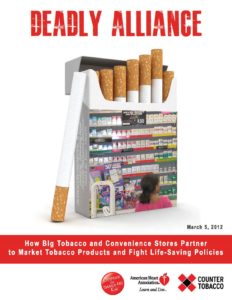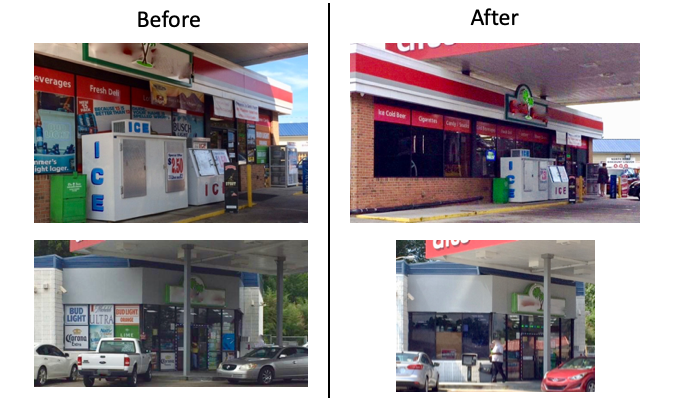Restricting Tobacco Advertising
Restrictions on tobacco industry advertising and promotions at the point-of-sale are effective strategies for counteracting the tobacco industry’s efforts to attract new, current, and recently quit smokers.
According to the Federal Trade Commission, in 2022 alone, the tobacco industry spent over $8.3 billion on marketing for cigarettes and smokeless tobacco, spending more at the point-of-sale than anywhere else. They spent nearly $51.4 million on advertisements at the point of sale alone.
Tobacco industry marketing, advertising and promotions have been found to:
- Encourage youth smoking uptake.[1, 2, 3, 4] The NCI has demonstrated a causal relationship between exposure to tobacco advertisements and youth smoking uptake. Across multiple studies, research has shown that youth more frequently exposed to tobacco promotion are 60% more likely to have tried smoking and 30% more likely to be susceptible to future smoking.[5] Read more.
- Increase total cigarette sales.[6, 7]
- Distort youth perceptions about the availability, use and popularity of cigarettes.[2, 3] Read more on the impact of tobacco retailers near schools and the Center for Public Health and Tobacco Policy’s fact sheet “Influencing Youth at the POS.”
- Foster positive brand imagery.[8]
- Cue cravings and undermine quit attempts.[2, 9, 10, 11]
- Fuel tobacco-related disparities. The tobacco industry has a long history of targeted marketing toward low income and minority populations[12,13] Read more on disparities in point of sale advertising.
For more information on the impact of tobacco marketing, advertising and promotions, review this fact sheet developed by the California Department of Public Health. To learn more about the the problem and why retail tobacco control is important read Counter Tobacco’s “War in the Store” and “Why Retail Tobacco is Important” pages or read the Deadly Alliance Report.
What are POS Advertising Restrictions?
The 2009 Family Smoking Prevention and Tobacco Control Act gave states and local governments the power to enact certain restrictions on tobacco advertising. Review this presentation by ChangeLab Solutions and the Public Health Law Center to learn more about how the 2009 Act impacts regulation of tobacco advertising and promotions.
The Public Health Law Center suggests the following strategies for restricting tobacco advertising at the point of sale. Refer to their guide, “Restricting Tobacco Advertising” for more details:
- Restrict ALL advertising without regard to its content (“content neutral” advertising restriction). This would affect advertising for all products (e.g. alcohol, food, toys, etc.), not just tobacco. For example, some municipalities limit the percentage of window space that can be taken up by advertisements of any kind, place limits on the size or number of advertisements allowed, or restrict the location of advertisements. Learn more in the Public Health Law Center’s guide to Content-Neutral Advertising Laws.
- Restrict the content, messages, or imagery within some tobacco advertisements.
- Restrict the time, place and/or manner (but not the content) of tobacco advertising. The following examples illustrate potential time, place and manner restrictions:
-
- Time restrictions: Require retailers to cover or remove advertising during times when youth are present (e.g., after school hours).
- Place restrictions: Prohibit tobacco advertising at stores near schools or within 10 feet of the cash register. For example, the State of New York has prohibited the display of exterior tobacco advertisements within 1500 feet of schools (500 feet within New York City).
- Manner restrictions: Prohibit certain types of tobacco advertising (e.g. outdoor signage or sandwich board style ads). For example, Colorado prohibits retailers form advertising e-cigarette products in a manner that is visible from outside.
You can implement POS advertising restrictions through three main mechanisms:
- State or local laws or ordinances: Laws can be passed at the state or local level to directly restrict tobacco advertising. The 2009 Family Smoking Prevention & Tobacco Control Act gave state and local governments the authority to enact these restrictions, in order to address public health concerns, especially protecting youth from the harms of tobacco.
- Licensing laws: Advertising restrictions can be incorporated as stipulations (or “plug-ins”) of tobacco retail licensing. See Counter Tobacco’s page on Licensing and Zoning for more information about tobacco retail licensing. Licensing laws that affect the density, location or type of tobacco retailers will also inherently reduce exposure to POS advertising.
- Zoning laws: Zoning laws can restrict advertising for retailers in certain zones. Some communities have “sign laws” that regulate how advertisements can be posted, which are usually content neutral restrictions. See Counter Tobacco’s page on Licensing and Zoning for more information about zoning. Zoning regulations that impact the density, location or type of tobacco retailers will also inherently reduce exposure to POS advertising.
Another way to reduce exposure to tobacco advertising at the point of sale is through more comprehensive tobacco control policies, including limits on the the number of retailers in a community that can sell tobacco, restrictions on the types of products sold, and/or prohibiting price promotions and discounts.[18] For example, a study evaluating the impacts of restrictions on the sale of flavored tobacco products found that in cities with restrictions on the sale of flavored tobacco products, exterior store advertising for tobacco products overall decreased following implementation of the policies to a greater extent than cities without a restriction in place.[19]
The evidence for implementing POS advertising restrictions
The tobacco industry channels the vast majority of its marketing expenditures to the point of sale, making POS advertising restrictions a critical strategy to subvert industry attempts to attract new, current, and recently quit smokers. Since few US states and localities have successfully implemented POS advertising restrictions, their impact in the US is not well known, but they are expected to reverse some of the effects of advertising, such as reducing youth uptake, reducing tobacco-related disparities, and changing norms about tobacco use. In fact, a global study recently showed that POS advertising bans reduce experimental smoking among youth by 31%.[14] The World Health Organization’s Framework Convention on Tobacco Control calls for comprehensive restrictions on tobacco advertising and international studies have found that these policies do in fact reduce consumption[15] and perceived prevalence of smoking by youth.[16] To learn more about limiting product displays and “power walls,” which the tobacco industry consider part of its advertising strategy, visit our page on restricting tobacco product placement.
 After conducting retail store assessments at all 26 retailers in Bamberg County and receiving training on point-of-sale tobacco control from Counter Tools, the Tri-County Commission on Alcohol and Drug Abuse (TCCADA) was looking for next steps to help address the glut of tobacco marketing present in their community. As the name implies, the Commission covers two other counties in South Carolina: Orangeburg and Calhoun. TCCADA planned to conduct store assessments in those two counties as well, and they took a look at the tobacco control laws currently on the books in all three counties. What they found was a happy surprise: both the county and the city of Orangeburg already had a policy on the books within their zoning ordinance that limits the amount of advertising on the exterior of stores to 25% of the wall area. However, this signage ordinance had not been enforced. TCCADA’s agency director contacted the county administrator and zoning administrator, who sent out warning letters to stores, notifying them of the ordinance and notifying them that there would be upcoming inspections to ensure compliance with the code. Learn more here.
After conducting retail store assessments at all 26 retailers in Bamberg County and receiving training on point-of-sale tobacco control from Counter Tools, the Tri-County Commission on Alcohol and Drug Abuse (TCCADA) was looking for next steps to help address the glut of tobacco marketing present in their community. As the name implies, the Commission covers two other counties in South Carolina: Orangeburg and Calhoun. TCCADA planned to conduct store assessments in those two counties as well, and they took a look at the tobacco control laws currently on the books in all three counties. What they found was a happy surprise: both the county and the city of Orangeburg already had a policy on the books within their zoning ordinance that limits the amount of advertising on the exterior of stores to 25% of the wall area. However, this signage ordinance had not been enforced. TCCADA’s agency director contacted the county administrator and zoning administrator, who sent out warning letters to stores, notifying them of the ordinance and notifying them that there would be upcoming inspections to ensure compliance with the code. Learn more here.
 Tobacco Free New York State (TobaccoFreeNYS) is a non-profit organization dedicated to making New York State a healthier place to live, work, and play. Their media campaign, “Tobacco Marketing Works,” aims to “educate New Yorkers about the dangers of tobacco industry marketing in retail stores, and the effect that this marketing has on New York’s youth” and asks local retailers to “remove, reduce or rearrange” tobacco advertising in and around their stores. Visit TobaccoFreeNYS.org for links to audio, video and print ads, as well as a host of community resources to counter industry marketing at the point of sale. Also see TobaccoFreeNYS on YouTube:
Tobacco Free New York State (TobaccoFreeNYS) is a non-profit organization dedicated to making New York State a healthier place to live, work, and play. Their media campaign, “Tobacco Marketing Works,” aims to “educate New Yorkers about the dangers of tobacco industry marketing in retail stores, and the effect that this marketing has on New York’s youth” and asks local retailers to “remove, reduce or rearrange” tobacco advertising in and around their stores. Visit TobaccoFreeNYS.org for links to audio, video and print ads, as well as a host of community resources to counter industry marketing at the point of sale. Also see TobaccoFreeNYS on YouTube:
Best Practices for Getting Started
- Determine if your state preempts localities from enacting restrictions on tobacco marketing, advertising, or promotions. Preemption means that the laws at a higher level of government take precedence over the laws at a lower level of government. Learn more here.
- Consult legal experts before you pursue any policy. In particular, regulations on tobacco advertising and promotions are advanced policies and may face legal challenges, so it is important to understand be aware of the legal landscape and carefully design a law to avoid legal issues. The content on this site and associated resources are no substitute for actual legal advice. Attempts at implementing restrictions may face legal challenges related to the commercial speech clause of the First Amendment and the commerce clause. The following resources, developed by the Public Health Law Center and the Center for Public Health & Tobacco Policy, can help you understand how a proposed policy may be viewed by the courts:
- Conduct store assessments (such as a Walking Tobacco Audit, STARS, or vSTARS ) and publicize results. Documenting the amount and type of tobacco marketing, advertising and promotions in your community can be a powerful way to draw attention to the problem and garner support. For example, if you are concerned about or want to restrict tobacco advertising near schools or other youth-centric places, collect evidence about the types of stores frequented by youth and the amount of marketing present in those stores.[17] Using mapping software is a great way to illustrate the boundaries of an advertising or sale ban. You can also share images of tobacco advertising and promotions in your community or view images from other communities through Counter Tobacco’s image gallery.
- Conduct public opinion surveys to measure awareness of and support for point of sale policies.
- Engage stakeholders. Review the CDC’s Best Practices for Comprehensive Tobacco Control Programs for tips.
- Include robust enforcement and compliance measures in any proposed policy.


